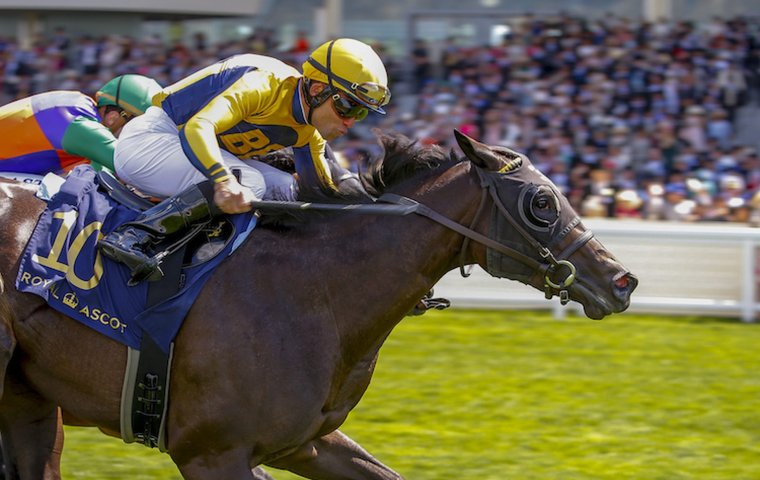
Once upon a time, back in 1984, the Breeders’ Cup consisted of a single day of racing with seven stakes worth a combined $10 million. Suffice it to say, those days are long gone.
 As the Breeders’ Cup prepares for its milestone 35th edition, its tremendous growth and popularity are reflected in the scope of the event that will take place at Churchill Downs on Friday and Saturday.
As the Breeders’ Cup prepares for its milestone 35th edition, its tremendous growth and popularity are reflected in the scope of the event that will take place at Churchill Downs on Friday and Saturday.
A one day event? Now it’s two.
Seven races? There are now twice as many, specifically 14 and there has been as many as 15.
Ten million dollars in purse money? Try nearly tripling the money at stake to $28 million.
Yes, growth can be a very nice thing.
“We’ve reached an excellent level of races and participation,” said Dora Delgado, Senior Vice President of Racing and Nominations for the Breeders’ Cup.
Yet change can also be tricky as an increase in races has created a dilemma over the years for the Breeders’ Cup in terms of handling bigger cards. How do you mix and match races among two days?
A separate stage for the stars of tomorrow
This year, a new Friday format will be unveiled with a slate of five races, all of them for 2-year-olds. Marketed under the banner of ‘Future Stars Friday’, the quintet consists of the BC Juvenile Turf Sprint, which is making its debut at the World Championships, the Juvenile Fillies Turf, the Juvenile Turf, the Juvenile Fillies and the Juvenile. The new package replaces the previous format with the BC Distaff as its cornerstone, with the hope that a separate stage for the stars of tomorrow will bring added interest in the Friday program.
“We started with the Friday card at Monmouth (in 2007) with a few races, and we’ve been trying to build its identity since then. We’ve been looking for something that would resonate with fans and handicappers and people watching on television. Unfortunately, Ladies Day never caught on,” Delgado said. “What we decided was that, with the addition of the Juvenile Turf Sprint, we had a nice, solid line-up of five juvenile races that could be split off by themselves.”
Delgado said the idea of making the Friday card a showcase for juveniles was first tossed out by Breeders’ Cup President and CEO Craig Fravel two years ago, but, with the series taking place at Churchill Downs, the timing finally seemed right to implement it.
“The Distaff was the only race that caught people’s imagination on Friday, and we thought Churchill Downs would be a great place to roll out the Future Stars format,” Delgado said. “Since we are trying to promote the 2-year-olds as the future stars that you will see next year in the Kentucky Oaks and the Kentucky Derby, we thought it was natural to launch that concept at Churchill Downs, where those races will be held next year.”
In addition to the five Breeders’ Cup juvenile races, Churchill Downs has shifted the Street Sense Stakes, a $100,000 contest for 2-year-olds at a mile, to the Friday card.
“We want to have a theme that will give people a reason to come on Friday and this might be something that has a chance to build and grow. It gets the babies kind of out of the way on a day when there’s not as much hoopla as Saturday. It’s a day just for the 2-year-olds, and their trainers can focus on getting them ready for their race. We’re hoping this schedule will encourage more owners to be there on Friday,” Delgado said. “We’ve been pleased so far with the reception it’s received.”
Baffert’s reservations
The five juvenile races will be aired on NBCSN, and Gary Quinn, Vice President of Programming for NBC Sports and NBCSN, voiced support for the new format.
“We are excited to present Friday and Saturday Breeders’ Cup shows highlighted by some of the year’s biggest races and most competitive fields. We are also looking forward to showcasing the new format that Breeders’ Cup has developed this year,” he said.
Of course, finding 100 percent agreement in the racing industry is an impossible dream. Two-time Triple Crown-winning trainer Bob Baffert said he would prefer to see the BC Distaff on the Friday card and the BC Juvenile on the Saturday card – with a purse bump to $3 million for the 2-year-old race.
“I wish the Distaff was Friday not Saturday. I think they shifted the races to sell more tickets. They are trying to mimic the Oaks-Derby Friday-Saturday format and give you a reason to be there for two days,” Baffert said. “But the 2-year-old colts are our horses of the future and they should be showcased on Saturday, along with the other original [seven] races. They should also raise them to at least $3 million a race.”
The Breeders’ Cup had eight races in 2006, but, when three races were added in 2007 at rain-soaked Monmouth Park, all the new races (Filly & Mare Sprint, Juvenile Turf and C Dirt Mile) were contested on Friday.
At the same time, an era of change was ushered in.
In 2008, the number of races jumped to 14 with the addition of the Juvenile Fillies Turf, the Marathon, the Turf Sprint and the Juvenile Turf. In response, the Distaff was renamed the Ladies Classic and was shifted to Friday, which was packaged as Ladies Day. Joining the Ladies Classic was the Filly & Mare Sprint, the Juvenile Fillies Turf, the Juvenile Fillies and the Filly & Mare Turf.
The Marathon moved to Friday in 2009 and, in 2011, a 15th stakes was added when the Juvenile Sprint (on dirt) was introduced on the Friday card and the Marathon shifted back to Saturday.
The following year, the Filly & Mare Sprint was placed on Saturday’s card and the Marathon jogged back to Friday.
Unable to gain traction
There was even more substantial change in 2013, starting with the Ladies Classic re-assuming its original name as the BC Distaff. Ladies Day became a thing of the past as three races for males, the Marathon, the Juvenile Turf and the Dirt Mile, joined the Distaff and Juvenile Fillies Turf to form Friday’s five races.
At the same time, the Juvenile Sprint was dropped after five horses turned out for the 2012 edition.
“The feedback we got on the Juvenile Sprint was that most of our trainers at that time of year are trying to stretch out their 2-year-olds to get them to the Kentucky Derby distance by May. It wasn’t very popular,” Delgado said. “Basically, we were getting maidens and that’s not very helpful in getting a stakes graded.”
The changes continued in 2014, when the Marathon was cancelled, but the remaining Friday foursome remained in place until this year.
Given all the changes, Friday attendance figures were unable to gain traction. The best figure to date was a crowd of 45,673 in 2016 at Santa Anita. The next day 72,811 turned out for the Saturday card.
Now the hope is that a day for juveniles will give the day some stability and appeal.
“We thought it would be a nice handicapping angle to have a Pick 5 with all juvenile races and then end the day with the race that will point out the favorite for the Kentucky Derby next year,” Delgado said.
Key ingredient
A key ingredient in the mix was the creation of the Juvenile Turf Sprint, which has proven to be quite popular with horsemen on both shores. The new race attracted 28 pre-entries and figures to break from the gate with a full field of 12 starters on Friday.
Designed to encourage American and foreign breeders to nominate their stallions with a sprint and grass pedigree, it caters to European trainers whose 2-year-olds have dozens of opportunities to run in sprint stakes on turf. Meanwhile, in the United States, it created a new opportunity for 2-year-olds as two stakes were created – the Indian Summer at Keeneland and Speakeasy at Santa Anita - and two historic dirt stakes, the Futurity and the Matron at Belmont Park, became turf races to stock the race.
The Futurity, Indian Summer and Speakeasy were also designated as Breeders’ Cup Challenge races with the winners getting a free spot in the BC Juvenile Turf Sprint. The Norfolk Stakes at Royal Ascot was also chosen as a ‘Win and You’re In’ race, and, ironically enough, American trainer Wesley Ward grabbed that spot with his 2-year-old filly Shang Shang Shang.
“We had been running a turf sprint on the undercard and it was well-received so we knew this race would be a popular addition,” Delgado said.
Delgado said in a few years Breeders’ Cup officials will analyze the results and they may decide to add a version of the race for females. For now, that talk is on hold, but don’t be surprised when it happens.
Change is not necessarily a bad thing when it comes to the Breeders’ Cup.


